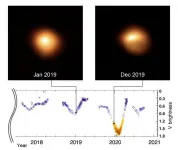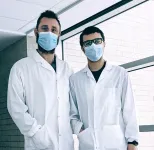(Press-News.org) Betelgeuse is normally one of the brightest, most recognizable stars of the winter sky, marking the left shoulder of the constellation Orion. But lately, it has been behaving strangely: an unprecedentedly large drop in its brightness has been observed in early 2020 (Figure 1), which has prompted speculation that Betelgeuse may be about to explode.
To find out more, an international team of scientists, including Ken'ichi Nomoto at the Kavli Institute for the Physics and Mathematics of the Universe (Kavli IPMU), conducted a rigorous examination of Betelgeuse. They concluded that the star is in the early core helium-burning phase (which is more than 100,000 years before an explosion happens) and has smaller mass and radius--and is closer to Earth--than previously thought. They also showed that smaller brightness variations of Betelgeuse have been driven by stellar pulsations, and suggested that the recent large dimming event involved a dust cloud.
The research team is led by Dr. Meridith Joyce from the Australian National University (ANU), who was an invited speaker at Kavli IPMU in January 2020, and includes Dr. Shing-Chi Leung, a former Kavli IPMU project researcher and a current postdoctoral scholar at the California Institute of Technology, and Dr. Chiaki Kobayashi, an associate professor at the University of Hertfordshire, who has been an affiliate member of Kavli IPMU.
The team analyzed the brightness variation of Betelgeuse (Figure 2) by using evolutionary, hydrodynamic and seismic modelling. They achieved a clearer idea than before that Betelgeuse is currently burning helium in its core. They also showed that stellar pulsations driven by the so-called kappa-mechanism is causing the star to continuously brighten or fade with two periods of 185 (+-13.5) days and approximately 400 days. But the large dip in brightness in early 2020 is unprecedented, and is likely due to a dust cloud in front of Betelgeuse, as seen in the image (Figure 1).
Their analysis reported a present-day mass of 16.5 to 19 solar mass--which is slightly lower than the most-recent estimates. The study also revealed how big Betelgeuse is, as well as its distance from Earth. The star's actual size has been a bit of a mystery: earlier studies, for instance, suggested it could be bigger than the orbit of Jupiter. However, the team's results showed Betelgeuse only extends out to two-thirds of that, with a radius 750 times the radius of the sun. Once the physical size of the star is known, it will be possible to determine its distance from Earth. Thus far, the team's results show it is a mere 530 light years from us, or 25 percent closer than previously thought.
Their results imply that Betelgeuse is not at all close to exploding, and that it is too far from Earth for the eventual explosion to have significant impact here, even though it is still a really big deal when a supernova goes off. And as Betelgeuse is the closest candidate for such an explosion, it gives us a rare opportunity to study what happens to stars like this before they explode.
INFORMATION:
Related Links:
Click here to view the press release from ANU
(https://www.anu.edu.au/news/all-news/supergiant-betelgeuse-smaller-closer-than-first-thought)
Click here to view the press release from Konkoly Observatory of the Research Centre for Astronomy and Earth Sciences (CSFK) / the web-page of Eötvös Loránd Research Network (ELKH)
(https://elkh.org/en/news/supergiant-star-betelgeuse-smaller-closer-than-first-thought/)
Paper details
Journal: The Astrophysical Journal
Title: Standing on the Shoulders of Giants: New Mass and Distance Estimates for Betelgeuse through Combined Evolutionary, Asteroseismic, and Hydrodynamic Simulations with MESA
Authors: Meridith Joyce (1,2), Shing-Chi Leung (3), László Molnár (4, 5, 6), Michael Ireland (1), Chiaki Kobayashi (2, 7, 8), Ken'ichi Nomoto (8)
Author affiliation:
1. Research School of Astronomy and Astrophysics, Australian National University (ANU), Canberra, ACT 2611, Australia
2. ARC Center of Excellence for All Sky Astrophysics in 3 Dimensions (ASTRO 3D), Australia
3. TAPIR, Walter Burke Institute for Theoretical Physics, Mailcode 350-17, Caltech, Pasadena, CA 91125, USA
4. Konkoly Observatory, Research Center for Astronomy and Earth Sciences (CSFK), Konkoly-Thege út 15-17, H-1121 Budapest, Hungary
5. MTA CSFK Lendulet Near-Field Cosmology Research Group, Konkoly-Thege út 15-17, H-1121 Budapest, Hungary
6. ELTE Eotvs Loránd University, Institute of Physics, Budapest, 1117, Páz mány Péter sétány 1 / A, Hungary
7. Center for Astrophysics Research, Department of Physics, Astronomy and Mathematics, University of Hertfordshire, College Lane, Hatfield AL10 9AB, UK
8. Kavli Institute for the Physics and Mathematics of the Universe (WPI), The University of Tokyo Institutes for Advanced Study, The University of Tokyo, Kashiwa, Chiba 277-8583, Japan
DOI: https://doi.org/10.3847/1538-4357/abb8db (Posted on October 13, 2020)
Abstract of the paper: (The Astrophysical Journal)
Pre-print: (arXiv.org page)
Research contact:
Ken'ichi Nomoto
Senior Scientist
Kavli Institute for the Physics and Mathematics of the Universe, University of Tokyo
E-mail: nomoto_at_astron.s.u-tokyo.ac.jp
TEL: +81-4-7136-5940
Please change * _at_ to @
Media contact:
John Amari
Press officer
Kavli Institute for the Physics and Mathematics of the Universe, The University of Tokyo
E-mail: press_at_ipmu.jp
TEL: 080-4056-2767
Please change *_at_ to @
A study reveals the genetic factors that may expose or protect people with Down syndrome from SARS-CoV-2 infection, as well as the prognosis of COVID-19.
Their findings, which are published in the journal Scientific Reports, follow previous studies showing a tenfold mortality risk of COVID-19 for people with Down syndrome, adding further evidence to boost existing calls for priority vaccination of the medically vulnerable group.
The researchers analysed all publicly available Down syndrome transcriptomic data to uncover alterations that might affect SARS-CoV-2's infection and disease progression.
TMPRSS2, a gene that codes for an enzyme critical for aiding the entry of SARS-CoV-2 in human cells, had 60% higher levels ...
A study carried out at the University of Helsinki indicates that agricultural activity confuses the mechanisms that regulate the occurrence of plant diseases in nature. A wider variety of virus species was found in meadows close to agricultural fields compared to those located in natural surroundings, with the richness of plant species having no effect on the number of virus species. However, maintaining biodiversity is worthwhile, as plant richness did reduce the number of viral infections in the meadows.
An increasing share of the global land area is used for agricultural purposes, with more and more of the remaining area located at the boundary between agricultural and natural land, also known as the agro-ecological ...
As part of a worldwide collaboration, Carnegie Mellon University chemists have helped discover that iodic acids can rapidly form aerosol particles in the atmosphere, giving scientists more knowledge of how iodine emissions can contribute to cloud formation and climate change.
"Essentially all uncertainty around climate change and the atmosphere has something to do with particles and cloud droplets," said Neil Donahue, Thomas Lord University Professor of Chemistry and a professor in the departments of Chemical Engineering, and Engineering and Public Policy. The Donahue ...
Face masks mandates have led people to spend less time at home, but whether this has exposed Americans to more risk is still a question, according to a new study published Thursday in Scientific Reports.
Using anonymized location data from smart devices, the study, conducted by Yale School of the Environment Professor Eli Fenichel, Youpei Yan, YSE postdoctoral associate, Colorado State University Assistant Professor Jude Bayham and Aaron Richter, a Yale research affiliate, examined changes in behavior of residents two weeks before and two weeks after mask mandates were implemented in regions of the United States.
The study found that residents spent between 11-24 more minutes outside their homes after a facemask mandate was issued, even as COVID-19 rates were rising in the U.S. ...
A new study of autism risk genes by UC San Francisco and UC Berkeley scientists implicates disruption in prenatal neurogenesis - a process in which specialized "progenitor" cells give rise to new brain cells - in the development of autism spectrum disorders (ASDs). The study also shows that estrogen, perhaps in a form produced within brain cells, can protect against this disruption and steer the brain on a normal course of development.
The most striking findings in the study, published on January 25, 2021 in Neuron, were derived from experiments using embryos of the western clawed frog (Xenopus tropicalis), a species prized by biologists for the unique insights it offers into development. Human genes involved in development ...
Prompted by the need to improve conventional treatments for people infected with the human immunodeficiency virus (HIV-1), a team from the Institut national de la recherche scientifique (INRS) has identified a therapeutic approach to restore the effectiveness of immune cells. The study, led by doctoral student Hamza Loucif and Professor Julien van Grevenynghe, was published in the journal Autophagy.
Most people infected with HIV-1 require daily antiretroviral therapy to control the infection. These drugs cause significant side effects without fully restoring the normal functioning of the immune system. ...
SPOKANE, Wash. - Diabetic patients taking the natural product goldenseal while taking the prescription drug metformin may be unwittingly sabotaging their efforts to maintain healthy blood glucose levels. This concern arose from a recent study published in the journal Clinical Pharmacology & Therapeutics.
Metformin--the world's most-prescribed oral glucose-lowering medication--was included in a cocktail of selected drugs given to participants in a clinical study led by scientists at Washington State University's College of Pharmacy and Pharmaceutical Sciences. The study sought to determine the impact of goldenseal on specific ...
A new study by scientists at Utrecht University and the United Nations University concludes that about half of global wastewater is treated, rather than the previous estimate of 20%. Despite this promising finding, the authors warn that treatment rates in developing countries are still very low. The study and its dataset were published Open Access in the journal Earth System Science Data.
Humans and factories produce vast quantities of wastewater per day. If not properly collected and treated, wastewater may severely threaten human health and pollute the environment.
144 million swimming pools
The authors use national statistics to estimate volumes of wastewater production, collection, treatment and reuse. "Globally, about 359 ...
Faster speech rate, greater intensity in the middle of the word, and falling pitch at the end of the word: that is the prosody[1] to adopt if one wants to come across as reliable and honest to one's listeners. Scientists from the Science and Technology for Music and Sound laboratory (CNRS/Ircam/Sorbonne Université/Ministère de la Culture)[2] and the Perceptual Systems Laboratory (CNRS/ENS PSL) have conducted a series of experiments[3] to understand how we decide, based on the voice, whether a speaker is honest and confident, or on the contrary dishonest and uncertain. They have also shown that this signature was perceived similarly ...
The sense of hearing is, quite literally, a molecular tightrope act. Turns out, it involves acrobatics as well.
In a paper published in Nature Communications on Feb 8, researchers at Harvard Medical School and Boston Children's Hospital show that a dynamic and delicate connection between two pairs of diminutive protein filaments plays a central role in in hearing.
The tension held by these filaments, together called a tip link, is essential for the activation of sensory cells in the inner ear. The team's analyses reveal that the filaments, which are joined end-to-end, work together like trapeze artists holding ...




